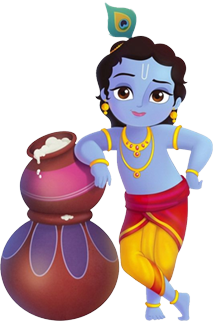


Sri Radha Raman Mandir is situated close to Nidhi Van. It was constructed at the request of Gopala Bhatta Goswami around 1542 and is one of the most exquisitely crafted and revered temples of Vrindavan, particularly by the Goswamis (Gaudiya Vaishnavas). It still houses the original saligram deity of Krishna, the smallest idol famous in Braj, along with an image of Radha. The samadhis of Gopal Bhatt and other disciples are in the same compound, behind the temple.
Established by Gopala Bhatta Goswami, this temple is dedicated to Lord Krishna as Radha Ramana. He is one of the six Goswamis of Vrindavan who followed the principles of Sri Chaitanya Mahaprabhu strictly. The temple is exquisitely crafted and one of the most revered temples in Vrindavan, especially by the followers of Gaudiya Vaishnavism. It houses the original shaligram deity of Krishna, alongside Radharani. The temple was renovated in the year 1826 by Shah Behari Lallji.
The deity is self-manifested from a shaligram shila, which is around 30 cm tall and has a mystic smile on his face. The deity was installed on the full moon day in the month of Vaishaka (April-May) in the year 1542. This event is celebrated every year by bathing the deity with milk and other favorable items. There is no deity of Radharani in this temple, but a crown is kept next to Krishna signifying her presence.
The Samadhi of Gopala Bhatta is located next to Radha - Raman Temple. It is believed that there are markings of discs on the back and feet of the statue.
History of the Temple
The temple of Sri Radha Raman was built by Gopal Bhatta Goswami (one of the disciples of Chaitanya Mahaprabhu), some 500 years back. Gopal Bhatta Goswami visited Vrindavan at the age of thirty. Upon arrival, he received the divine blessings of Chaitanya Mahaprabhu. However, the blessings were in the form of Kopin (loincloth of Chaitanya), Patta, (wooden seat), Dupatta (long piece of cloth). Amongst all these, the wooden seat is well-preserved, and hence, can be seen at the temple.
On the instruction of Chaitanya Mahaprabhu, Gopal Bhatt Goswami went to Kali-Gandaki River in Nepal. Having been blessed by Chaitanya Mahaprabhu, Goswami found 12 Shalligrams Shillas. He brought those 12 Shillas to Vrindavan and started worshipping them with intense devotion. These Shillas were worshipped by Goswami in their original form. However, he always desired to worship the divine form of the Lord, i.e., an image which could be fed, touched and dressed up.
With the passing of years, his desire kept getting stronger. Finally, on the day of Narasimha Chaturdashi in May 1542, Gopal Bhatta Goswami reminisced on the glory of Lord Narasimha (an avatar of Lord Vishnu, he was half human and half lion). The next day, when he got up for his morning prayer, he saw the open lid of the basket in which he had kept the Shillas. When he opened the lid, he found the exquisite idol of the deity along with 11 other Shillas. The idol was the 12th Shilla (Damodar Shilla) which got transferred into the image of Lord Krishna.